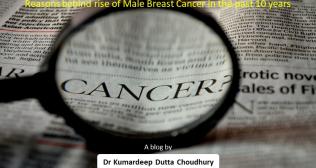
Oncology
Curing Breast Cancer With Radiotherapy
Curing Breast Cancer With Radiotherapy Sep 09, 2015
Breast cancer is one of the leading causes of cancer in women worldwide. In India too, the incidence of breast cancer is on the rise in urban areas, where it has overtaken cervical cancer.
Breast Conserving Therapy (BCT) is now a standard treatment in the management of early breast cancer. Several large series have confirmed the equivalence of BCT compared to mastectomy in terms of disease free and overall survival rates. The major benefit of BCT is the preservation of the affected breast with significant consequent advantages in terms of psychological function and quality of life. Women preferring BCT want to avoid the feelings of disfigurement, mutilation and insult to femininity that is feared with modified radical mastectomy. The two important goals of BCT, therefore, are comparable local control and cosmetic outcome as compared to mastectomy. Cosmesis is an important endpoint while auditing treatment outcome and incorporates the sum total of the appearance of the breast after BCT and an aesthetic judgment of breast appearance. Cosmesis has the potential to influence physical, social and sexual functioning. A good cosmesis can therefore be considered as a cornerstone for the approach of BCT. Various patient, tumour and treatment related factors are known to affect the cosmetic outcome. While some of these factors have been established unequivocally, others still have undetermined significance.
RADIOTHERAPY
Radiotherapy (RT) to breast after breast conservation or to the chest wall and drainage areas after mastectomy results in 70 percent reduction in the incidence of local recurrence. Landmark trials from Denmark and British Columbia have shown survival benefit with the use of RT in post mastectomy cases of carcinoma breast. The same has been proven for breast conservation as well in the recent Oxford meta-analysis. Thus, RT is an integral part of treatment of breast cancer. It not only improves local control rates but has nearly five to seven percent absolute improvement in survival outcomes both in breast conservation as well as post mastectomy patients with large tumours or positive nodes. In short, all patients with breast cancer who undergo breast conservation should receive adjuvant radiotherapy. Also, all patients who undergo mastectomy and have a pathological tumour size of >5 cm or >3 positive nodes should receive post operative radiotherapy. There is, however, strong emerging evidence of the benefit of radiotherapy in mastectomised patients with one to three positive nodes as well.
RT to breast, however, also irradiates a portion of the heart, poses a risk of long-term cardiac toxicity especially in left-sided breast cancer. It is therefore imperative that radiation oncologists try to spare the heart as far as possible in their planning process. There have also been some concerns regarding lung toxicity and contra lateral breast dose. It is important to realise that the full expression of cardiac side effects takes as long as 15 years to manifest. Fortunately, modern radiotherapy has proven to significantly reduce these adverse effects, making it a very cost-effective modality for breast cancer treatment.
NEW ADVANCEMENTS
A few such newer advances in treatment planning include a switch from conventional fluoroscopic based methods to CT based simulation. The actual treatment planning advances include Accelerated Partial Breast Irradiation (APBI), 3 Dimensional Conformal Radiotherapy (3D CRT), Intensity Modulated Radiotherapy (IMRT) and Image Guided Radiotherapy (IGRT).
APBI is especially useful in a select group of breast cancer patients with favourable clinical and pathological features. The advantage with APBI is the reduction of treatment time from conventional six weeks to a mere 10 days or even shorter. Techniques such as IMRT and IGRT need to be judiciously used. If IMRT is used, it should be forward planning IMRT with a predominantly tangential field arrangement. These techniques are especially useful in treatment of patients with large breasts so as to avoid acute and late reactions in breast. Such techniques ensure precision treatment delivery and achieve greater dose homogeneity within the breast tissue. IMRT is also useful to some extent in sparing the critical structures such as the heart in patients with left-sided cancers.
RADIOTHERAPY IN BREAST CANCER HAS COME A LONG WAY. HIGH-LEVEL EVIDENCE COUPLED WITH MODERN RADIOTHERAPY TECHNOLOGY HAS LED TO EMERGENCE OF A NEW HORIZON IN BREAST CANCER CARE.
The two important goals of BCT, therefore, are comparable local control and cosmetic outcome as compared to mastectomy. Cosmesis is an important endpoint while auditing treatment outcome and incorporates the sum total of the appearance of the breast after BCT and an aesthetic judgment of breast appearance. Cosmesis has the potential to influence physical, social and sexual functioning. A good cosmesis can therefore be considered as a cornerstone for the approach of BCT. Various patient, tumour and treatment related factors are known to affect the cosmetic outcome. While some of these factors have been established unequivocally, others still have undetermined significance.
RADIOTHERAPY
Radiotherapy (RT) to breast after breast conservation or to the chest wall and drainage areas after mastectomy results in 70 percent reduction in the incidence of local recurrence. Landmark trials from Denmark and British Columbia have shown survival benefit with the use of RT in post mastectomy cases of carcinoma breast. The same has been proven for breast conservation as well in the recent Oxford meta-analysis. Thus, RT is an integral part of treatment of breast cancer. It not only improves local control rates but has nearly five to seven percent absolute improvement in survival outcomes both in breast conservation as well as post mastectomy patients with large tumours or positive nodes. In short, all patients with breast cancer who undergo breast conservation should receive adjuvant radiotherapy. Also, all patients who undergo mastectomy and have a pathological tumour size of >5 cm or >3 positive nodes should receive post operative radiotherapy. There is, however, strong emerging evidence of the benefit of radiotherapy in mastectomised patients with one to three positive nodes as well.
RT to breast, however, also irradiates a portion of the heart, poses a risk of long-term cardiac toxicity especially in left-sided breast cancer. It is therefore imperative that radiation oncologists try to spare the heart as far as possible in their planning process. There have also been some concerns regarding lung toxicity and contra lateral breast dose. It is important to realise that the full expression of cardiac side effects takes as long as 15 years to manifest. Fortunately, modern radiotherapy has proven to significantly reduce these adverse effects, making it a very cost-effective modality for breast cancer treatment.
NEW ADVANCEMENTS
A few such newer advances in treatment planning include a switch from conventional fluoroscopic based methods to CT based simulation. The actual treatment planning advances include Accelerated Partial Breast Irradiation (APBI), 3 Dimensional Conformal Radiotherapy (3D CRT), Intensity Modulated Radiotherapy (IMRT) and Image Guided Radiotherapy (IGRT).
APBI is especially useful in a select group of breast cancer patients with favourable clinical and pathological features. The advantage with APBI is the reduction of treatment time from conventional six weeks to a mere 10 days or even shorter. Techniques such as IMRT and IGRT need to be judiciously used. If IMRT is used, it should be forward planning IMRT with a predominantly tangential field arrangement. These techniques are especially useful in treatment of patients with large breasts so as to avoid acute and late reactions in breast. Such techniques ensure precision treatment delivery and achieve greater dose homogeneity within the breast tissue. IMRT is also useful to some extent in sparing the critical structures such as the heart in patients with left-sided cancers.
RADIOTHERAPY IN BREAST CANCER HAS COME A LONG WAY. HIGH-LEVEL EVIDENCE COUPLED WITH MODERN RADIOTHERAPY TECHNOLOGY HAS LED TO EMERGENCE OF A NEW HORIZON IN BREAST CANCER CARE.
 The two important goals of BCT, therefore, are comparable local control and cosmetic outcome as compared to mastectomy. Cosmesis is an important endpoint while auditing treatment outcome and incorporates the sum total of the appearance of the breast after BCT and an aesthetic judgment of breast appearance. Cosmesis has the potential to influence physical, social and sexual functioning. A good cosmesis can therefore be considered as a cornerstone for the approach of BCT. Various patient, tumour and treatment related factors are known to affect the cosmetic outcome. While some of these factors have been established unequivocally, others still have undetermined significance.
RADIOTHERAPY
Radiotherapy (RT) to breast after breast conservation or to the chest wall and drainage areas after mastectomy results in 70 percent reduction in the incidence of local recurrence. Landmark trials from Denmark and British Columbia have shown survival benefit with the use of RT in post mastectomy cases of carcinoma breast. The same has been proven for breast conservation as well in the recent Oxford meta-analysis. Thus, RT is an integral part of treatment of breast cancer. It not only improves local control rates but has nearly five to seven percent absolute improvement in survival outcomes both in breast conservation as well as post mastectomy patients with large tumours or positive nodes. In short, all patients with breast cancer who undergo breast conservation should receive adjuvant radiotherapy. Also, all patients who undergo mastectomy and have a pathological tumour size of >5 cm or >3 positive nodes should receive post operative radiotherapy. There is, however, strong emerging evidence of the benefit of radiotherapy in mastectomised patients with one to three positive nodes as well.
RT to breast, however, also irradiates a portion of the heart, poses a risk of long-term cardiac toxicity especially in left-sided breast cancer. It is therefore imperative that radiation oncologists try to spare the heart as far as possible in their planning process. There have also been some concerns regarding lung toxicity and contra lateral breast dose. It is important to realise that the full expression of cardiac side effects takes as long as 15 years to manifest. Fortunately, modern radiotherapy has proven to significantly reduce these adverse effects, making it a very cost-effective modality for breast cancer treatment.
NEW ADVANCEMENTS
A few such newer advances in treatment planning include a switch from conventional fluoroscopic based methods to CT based simulation. The actual treatment planning advances include Accelerated Partial Breast Irradiation (APBI), 3 Dimensional Conformal Radiotherapy (3D CRT), Intensity Modulated Radiotherapy (IMRT) and Image Guided Radiotherapy (IGRT).
APBI is especially useful in a select group of breast cancer patients with favourable clinical and pathological features. The advantage with APBI is the reduction of treatment time from conventional six weeks to a mere 10 days or even shorter. Techniques such as IMRT and IGRT need to be judiciously used. If IMRT is used, it should be forward planning IMRT with a predominantly tangential field arrangement. These techniques are especially useful in treatment of patients with large breasts so as to avoid acute and late reactions in breast. Such techniques ensure precision treatment delivery and achieve greater dose homogeneity within the breast tissue. IMRT is also useful to some extent in sparing the critical structures such as the heart in patients with left-sided cancers.
RADIOTHERAPY IN BREAST CANCER HAS COME A LONG WAY. HIGH-LEVEL EVIDENCE COUPLED WITH MODERN RADIOTHERAPY TECHNOLOGY HAS LED TO EMERGENCE OF A NEW HORIZON IN BREAST CANCER CARE.
The two important goals of BCT, therefore, are comparable local control and cosmetic outcome as compared to mastectomy. Cosmesis is an important endpoint while auditing treatment outcome and incorporates the sum total of the appearance of the breast after BCT and an aesthetic judgment of breast appearance. Cosmesis has the potential to influence physical, social and sexual functioning. A good cosmesis can therefore be considered as a cornerstone for the approach of BCT. Various patient, tumour and treatment related factors are known to affect the cosmetic outcome. While some of these factors have been established unequivocally, others still have undetermined significance.
RADIOTHERAPY
Radiotherapy (RT) to breast after breast conservation or to the chest wall and drainage areas after mastectomy results in 70 percent reduction in the incidence of local recurrence. Landmark trials from Denmark and British Columbia have shown survival benefit with the use of RT in post mastectomy cases of carcinoma breast. The same has been proven for breast conservation as well in the recent Oxford meta-analysis. Thus, RT is an integral part of treatment of breast cancer. It not only improves local control rates but has nearly five to seven percent absolute improvement in survival outcomes both in breast conservation as well as post mastectomy patients with large tumours or positive nodes. In short, all patients with breast cancer who undergo breast conservation should receive adjuvant radiotherapy. Also, all patients who undergo mastectomy and have a pathological tumour size of >5 cm or >3 positive nodes should receive post operative radiotherapy. There is, however, strong emerging evidence of the benefit of radiotherapy in mastectomised patients with one to three positive nodes as well.
RT to breast, however, also irradiates a portion of the heart, poses a risk of long-term cardiac toxicity especially in left-sided breast cancer. It is therefore imperative that radiation oncologists try to spare the heart as far as possible in their planning process. There have also been some concerns regarding lung toxicity and contra lateral breast dose. It is important to realise that the full expression of cardiac side effects takes as long as 15 years to manifest. Fortunately, modern radiotherapy has proven to significantly reduce these adverse effects, making it a very cost-effective modality for breast cancer treatment.
NEW ADVANCEMENTS
A few such newer advances in treatment planning include a switch from conventional fluoroscopic based methods to CT based simulation. The actual treatment planning advances include Accelerated Partial Breast Irradiation (APBI), 3 Dimensional Conformal Radiotherapy (3D CRT), Intensity Modulated Radiotherapy (IMRT) and Image Guided Radiotherapy (IGRT).
APBI is especially useful in a select group of breast cancer patients with favourable clinical and pathological features. The advantage with APBI is the reduction of treatment time from conventional six weeks to a mere 10 days or even shorter. Techniques such as IMRT and IGRT need to be judiciously used. If IMRT is used, it should be forward planning IMRT with a predominantly tangential field arrangement. These techniques are especially useful in treatment of patients with large breasts so as to avoid acute and late reactions in breast. Such techniques ensure precision treatment delivery and achieve greater dose homogeneity within the breast tissue. IMRT is also useful to some extent in sparing the critical structures such as the heart in patients with left-sided cancers.
RADIOTHERAPY IN BREAST CANCER HAS COME A LONG WAY. HIGH-LEVEL EVIDENCE COUPLED WITH MODERN RADIOTHERAPY TECHNOLOGY HAS LED TO EMERGENCE OF A NEW HORIZON IN BREAST CANCER CARE.



















